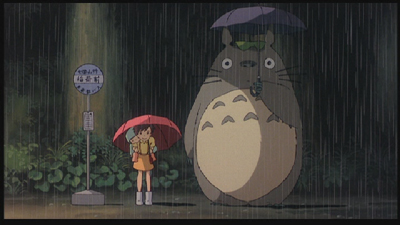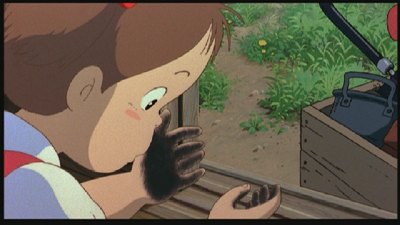 BUY IT AT AMAZON: CLICK HERE!
BUY IT AT AMAZON: CLICK HERE!
STUDIO: Disney
MSRP: $29.99
RATED: G
RUNNING TIME: 86 Minutes
SPECIAL FEATURES:
• "Behind the Microphone" featurette
• Opening/closing animation w/o credits
• TV spots and trailers
• Feature-length storyboard sequence
The Pitch
"Let’s
flip a coin. Heads I make a film that scares the pants off of children. Tails I
make a film that charms the pants off their parents. And it’s tails! Pants
off!"
The Humans
English
track: Dakota Fanning as Satsuki, Elle Fanning as Mei, and Frank Welker (the
voice of Nibbler in Futurama) as Totoro.
Japanese
track: Noriko Hidaka (Kikyo in Cartoon Network fave Inuyasha) as
Satsuki, Chika Sakamoto as Mei, and Hitoshi Takagi as the sublingual grumblings
of Totoro.

At least angels have the decency to say, "Do not be afraid."
The Nutshell
Two young
girls, Satsuki and Mei, move with their father to a quaint little cottage in
the country side while their mother recovers from an unnamed illness in a
nearby hospital. The girls waste no time exploring, and soon discover a small
treasure of ghosts and spirits in their old house. Instead of being frightened
away, the girls are fascinated, and treat the ghosts with respect. This leads
them into contact with one of the larger spirits, one who haunts a great
camphor tree, named Totoro.
If this
were an American film, Mei and Satsuki would immediately set out on a series of
madcap adventures with their egg-shaped new pal; but this is a
is an agenda. Fortunately for those bothered by spoon-fed morality in their
movies, the lessons
of respect, friendship, and family that the audience can sympathize with as the
slice-of-life plot moves toward a reunion of the girls with their mother.

In Japanese lore, it is customary to consult the Ubercheshire
before starting out on any sort of venture.
The Lowdown
Hayao
Miyazaki is that rare sort of filmmaker who seems to be able to slide
effortlessly between creating movies for children and movies for adults. Even
more rare is his ability to make his children’s movies appealing to adults, and
his more mature movies engaging for children. My Neighbor Totoro is a
perfect example of the former; there’s no arguing that its a film designed for
children, but it holds enough charm, artistry, and pathos to keep an adult
audience fully involved.
The plot,
what little there is, reminds me a bit of the classic A Little Princess (which
was adapted beautifully by Alfonso Cuaron.) Both stories are about children who
face down conflicts beyond their control, and situations in which bad things
happen to unsuspecting little girls. Neither Mei nor Satsuki have any control
over the dissolution of their family as a result of their mother’s illness, and
the theme of helplessness runs through the whole film.
One of
the challenges an adult audience faces with Totoro is that, despite
the thematic consistency, there really isn’t much in the way of plot. The
events that drive the theme — the mother’s sickness, a long wait for the
father’s return, a search for a lost child — are not connected to any sort of
common arc. It’s a slice-of-life story, a series of progressive vignettes that
don’t build to a resolution of characters as they do to a reaffirming of the
sense of helplessness with which a child must face the world.

Poor Mei’s toilet training was done at a ninty-degree rotation
to prepare her for the rigors of space travel.
It’s
through this young perspective that
the girls arrive at their new house, they immediately discover little
"soot gremlins" (who reappear, in a sense, in Spirited Away‘s boiler
room sequence) who inhabit the house. Their first reaction is to panic and
scream, but soon the fear of the unknown is tempered with a deep curiosity.
That’s an observation about children that
in process of finding where the line of motivation between fear and curiosity
should go. Totoro brings the line so far into the territory of curiosity,
you can see him addressing a child audience almost directly. He’s telling them
not to be afraid of the dark, of the shapes they don’t recognize, of the
unfamiliar sounds.
When seen
as a shot of courage for a young viewer, the film is charming as all hell for
an older one. Part of it is capitalizing on the envy that an adult might
naturally feel for both the film’s idyllic setting and its guileless
characters. For those in the right mindset, the memories of youth are recalled
— chasing frogs in the stream, playing in the mud, unaware of troubles as
parts of the now, and seeing them as
parts of the later.
The
mannerisms of children are replicated to great effect, as well. The animation
— always a
shows a lot of care in the crafting of Mei’s and Satsuki’s actions. Their
physical tics, such as Mei copying her older sister’s posture, or the two of
them momentarily turning a wrong corner in search of a door, invest them with a
lot of life, making this one of the most vibrant animated releases ever.
My Neighbor Totoro is a film that requires very
little effort from the viewer, and displays a deceptive amount of effort on the
parts of the filmmakers. From beginning to end, it is a delight, though its
narrative momentum could use some bolstering here and there. Its gentle message
of reliance on friends and respect for human decency isn’t so saccharine a set
of ideals as to clog the throat of a cynic. It’s the sort of film that is a
pleasure to watch; it’s absorbing, transporting, and competently-made.

Original sin manifests later — but more dramatically —
in the more adorable children.
The Package
The
bonuses here are about the same as those on Disney’s releases of Ghibli films.
A second disc is devoted to bonuses, and includes feature-length storyboards,
original promotional material, and a behind-the-scenes featurette of the
English-language dub. This set also includes the opening and closing credits
sequences without the credits cluttering things up. (Personally, I can’t stand
the cutesy little song included in the credits, because, in English, the singer
keeps switching which syllables receive emphasis. It just pisses me off.)
The audio
and video are of good quality, though the three language tracks are only in
plain Jane stereo. The video is presented in 1.85:1, and the transfer is
gorgeous. Some of the linework in the animation is extremely fine, and the
fidelity of the analog-to-digital conversion preserves the detail.
The cover
artwork is cute, and shows a scene that isn’t actually in the movie. What’s
great is that there’s so much going on in the picture. It brings on a lot of
small chuckles as your eye travels over it, which is a pretty good reflection
of the film inside.
7.9 out of 10